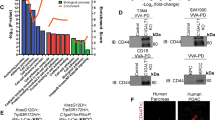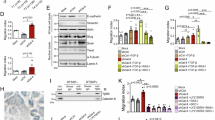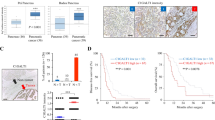Abstract
The attachment of cell-surface carbohydrates to proteins mediated by the amino acids serine or threonine (O-glycan) is involved in tumor metastasis; the roles of O-glycans vary depending on their structure, but the detailed mechanisms by which O-glycans trigger signaling to control tumor metastasis are largely unknown. In this study, we found that the reduced expression of core 3 synthase correlated with metastasis to lymph nodes and distant organs, resulting in poor prognosis for colorectal cancer (CRC) patients. Mechanically, we revealed that mucin-type core 3 O-glycan was synthesized at the membrane-tethered MUC1 N terminus because of core 3 synthase expression in colon cancer cells. This further inhibited the translocation of MUC1-C to the nucleus, initiated p53 gene transcription that was dependent on the inhibition of MUC1-C nucleus translocation, activated p53-mediated miR-200c expression and resulted in mesenchymal–epithelial transition (MET). Inhibition of MUC1 via small interfering RNA (siRNA) in re-expressed core 3 synthase colon cancer cells further inhibited MUC1-C nucleus translocation, increased p53 and miR-200c expression, and enhanced MET. However, inhibition of p53 via siRNA or miR-200c via miR-200c inhibitor in re-expressed core 3 synthase colon cancer cells promoted the epithelial–mesenchymal transition (EMT) in a reversible manner. Core 3 synthase mRNA levels and the p53 mRNA levels or miR-200c levels in the colon cancerous samples were positively correlated. Our findings suggest a novel mechanism linking mucin-type core 3 O-glycan to the EMT–MET plasticity of CRC cells via MUC1/p53/miR-200c-dependent signaling cascade and shed light on therapeutic strategies to treat this malignancy.
This is a preview of subscription content, access via your institution
Access options
Subscribe to this journal
Receive 50 print issues and online access
$259.00 per year
only $5.18 per issue
Buy this article
- Purchase on SpringerLink
- Instant access to full article PDF
Prices may be subject to local taxes which are calculated during checkout











Similar content being viewed by others
References
Levin B, Lieberman DA, McFarland B, Smith RA, Brooks D, Andrews KS et al. Screening and surveillance for the early detection of colorectal cancer and adenomatous polyps, 2008: a joint guideline from the American Cancer Society, the US Multi-Society Task Force on Colorectal Cancer, and the American College of Radiology. CA Cancer J Clin 2008; 58: 130–160.
Spaderna S, Schmalhofer O, Hlubek F, Berx G, Eger A, Merkel S et al. A transient, EMT-linked loss of basement membranes indicates metastasis and poor survival in colorectal cancer. Gastroenterology 2006; 131: 830–840.
Thiery JP, Acloque H, Huang RY, Nieto MA . Epithelial–mesenchymal transitions in development and disease. Cell 2009; 139: 871–890.
Hur K, Toiyama Y, Takahashi M, Balaguer F, Nagasaka T, Koike J et al. MicroRNA-200c modulates epithelial-to-mesenchymal transition (EMT) in human colorectal cancer metastasis. Gut 2013; 62: 1315–1326.
Shamir ER, Pappalardo E, Jorgens DM, Coutinho K, Tsai WT, Aziz K et al. Twist1-induced dissemination preserves epithelial identity and requires E-cadherin. J Cell Biol 2014; 204: 839–856.
Puisieux A, Brabletz T, Caramel J . Oncogenic roles of EMT-inducing transcription factors. Nat Cell Biol 2014; 16: 488–494.
Tsuboi S, Hatakeyama S, Ohyama C, Fukuda M . Two opposing roles of O-glycans in tumor metastasis. Trends Mol Med 2012; 18: 224–232.
Springer SA, Gagneux P . Glycomics: revealing the dynamic ecology and evolution of sugar molecules. J Proteomics 2016; 135: 90–100.
Moran AP, Gupta A, Joshi L . Sweet-talk: role of host glycosylation in bacterial pathogenesis of the gastrointestinal tract. Gut 2011; 60: 1412–1425.
Iwai T, Inaba N, Naundorf A, Zhang Y, Gotoh M, Iwasaki H et al. Molecular cloning and characterization of a novel UDP-GlcNAc:GalNAc-peptide beta1,3- N-acetylglucosaminyltransferase (beta 3Gn-T6), an enzyme synthesizing the core 3 structure of O-glycans. J Biol Chem 2002; 277: 12802–12809.
Iwai T, Kudo T, Kawamoto R, Kubota T, Togayachi A, Hiruma T et al. Core 3 synthase is down-regulated in colon carcinoma and profoundly suppresses the metastatic potential of carcinoma cells. Proc Natl Acad Sci USA 2005; 102: 4572–4577.
Radhakrishnan P, Grandgenett PM, Mohr AM, Bunt SK, Yu F, Chowdhury S et al. Expression of core 3 synthase in human pancreatic cancer cells suppresses tumor growth and metastasis. Int J Cancer 2013; 133: 2824–2833.
Bergstrom K, Fu J, Johansson ME, Liu X, Gao N, Wu Q et al. Core 1- and 3-derived O-glycans collectively maintain the colonic mucus barrier and protect against spontaneous colitis in mice. Mucosal Immunol 2017; 10: 91–103.
Gao N, Bergstrom K, Fu J, Xie B, Chen W, Xia L . Loss of intestinal O-glycans promotes spontaneous duodenal tumors. Am J Physiol Gastrointest Liver Physiol 2016; 311: G74–G83.
Pinho SS, Reis CA . Glycosylation in cancer: mechanisms and clinical implications. Nat Rev Cancer 2015; 15: 540–555.
Dimitroff CJ . Galectin-binding O-glycosylations as regulators of malignancy. Cancer Res 2015; 75: 3195–3202.
Du J, Hong S, Dong L, Cheng B, Lin L, Zhao B et al. Dynamic sialylation in transforming growth factor-beta (TGF-beta)-induced epithelial to mesenchymal transition. J Biol Chem 2015; 290: 12000–12013.
Lu J, Isaji T, Im S, Fukuda T, Hashii N, Takakura D et al. Beta-galactoside alpha2,6-sialyltranferase 1 promotes transforming growth factor-beta-mediated epithelial–mesenchymal transition. J Biol Chem 2014; 289: 34627–34641.
Tagde A, Rajabi H, Bouillez A, Alam M, Gali R, Bailey S et al. MUC1-C drives MYC in multiple myeloma. Blood 2016; 127: 2587–2597.
Kufe D . Oncogenic function of the MUC1 receptor subunit in gene regulation. Oncogene 2010; 29: 5663–5666.
Wei X, Xu H, Kufe D . Human mucin 1 oncoprotein represses transcription of the p53 tumor suppressor gene. Cancer Res 2007; 67: 1853–1858.
Kuan SF, Byrd JC, Basbaum C, Kim YS . Inhibition of mucin glycosylation by aryl-N-acetyl-alpha-galactosaminides in human colon cancer cells. J Biol Chem 1989; 264: 19271–19277.
Bergstrom K, Liu X, Zhao Y, Gao N, Wu Q, Song K et al. Defective intestinal mucin-type O-glycosylation causes spontaneous colitis-associated cancer in mice. Gastroenterology 2016; 151: 152–164 e111.
Tran DT, Ten Hagen KG . Mucin-type O-glycosylation during development. J Biol Chem 2013; 288: 6921–6929.
Rao X, Duan X, Mao W, Li X, Li Z, Li Q et al. O-GlcNAcylation of G6PD promotes the pentose phosphate pathway and tumor growth. Nat Commun 2015; 6: 8468.
Freire-de-Lima L, Gelfenbeyn K, Ding Y, Mandel U, Clausen H, Handa K et al. Involvement of O-glycosylation defining oncofetal fibronectin in epithelial–mesenchymal transition process. Proc Natl Acad Sci USA 2011; 108: 17690–17695.
Byrd JC, Bresalier RS . Mucins and mucin binding proteins in colorectal cancer. Cancer Metastasis Rev 2004; 23: 77–99.
Roy LD, Sahraei M, Subramani DB, Besmer D, Nath S, Tinder TL et al. MUC1 enhances invasiveness of pancreatic cancer cells by inducing epithelial to mesenchymal transition. Oncogene 2011; 30: 1449–1459.
Ponnusamy MP, Lakshmanan I, Jain M, Das S, Chakraborty S, Dey P et al. MUC4 mucin-induced epithelial to mesenchymal transition: a novel mechanism for metastasis of human ovarian cancer cells. Oncogene 2010; 29: 5741–5754.
Park JH, Katagiri T, Chung S, Kijima K, Nakamura Y . Polypeptide N-acetylgalactosaminyltransferase 6 disrupts mammary acinar morphogenesis through O-glycosylation of fibronectin. Neoplasia 2011; 13: 320–326.
Ye J, Pan Q, Shang Y, Wei X, Peng Z, Chen W et al. Core 2 mucin-type O-glycan inhibits EPEC or EHEC O157:H7 invasion into HT-29 epithelial cells. Gut Pathog 2015; 7: 31.
Radhakrishnan P, Dabelsteen S, Madsen FB, Francavilla C, Kopp KL, Steentoft C et al. Immature truncated O-glycophenotype of cancer directly induces oncogenic features. Proc Natl Acad Sci USA 2014; 111: E4066–E4075.
Lee SH, Hatakeyama S, Yu SY, Bao X, Ohyama C, Khoo KH et al. Core3 O-glycan synthase suppresses tumor formation and metastasis of prostate carcinoma PC3 and LNCaP cells through down-regulation of alpha2beta1 integrin complex. J Biol Chem 2009; 284: 17157–17169.
Macao B, Johansson DG, Hansson GC, Hard T . Autoproteolysis coupled to protein folding in the SEA domain of the membrane-bound MUC1 mucin. Nat Struct Mol Biol 2006; 13: 71–76.
Chang CJ, Chao CH, Xia W, Yang JY, Xiong Y, Li CW et al. p53 regulates epithelial–mesenchymal transition and stem cell properties through modulating miRNAs. Nat Cell Biol 2011; 13: 317–323.
Chou CH, Huang MJ, Chen CH, Shyu MK, Huang J, Hung JS et al. Up-regulation of C1GALT1 promotes breast cancer cell growth through MUC1-C signaling pathway. Oncotarget 2015; 6: 6123–6135.
Singh PK, Hollingsworth MA . Cell surface-associated mucins in signal transduction. Trends Cell Biol 2006; 16: 467–476.
Lillehoj EP, Kim H, Chun EY, Kim KC . Pseudomonas aeruginosa stimulates phosphorylation of the airway epithelial membrane glycoprotein Muc1 and activates MAP kinase. Am J Physiol Lung Cell Mol Physiol 2004; 287: L809–L815.
Tian Y, Pan Q, Shang Y, Zhu R, Ye J, Liu Y et al. MicroRNA-200 (miR-200) cluster regulation by achaete scute-like 2 (Ascl2): impact on the epithelial–mesenchymal transition in colon cancer cells. J Biol Chem 2014; 289: 36101–36115.
Zheng X, Carstens JL, Kim J, Scheible M, Kaye J, Sugimoto H et al. Epithelial–to-mesenchymal transition is dispensable for metastasis but induces chemoresistance in pancreatic cancer. Nature 2015; 527: 525–530.
Ye X, Tam WL, Shibue T, Kaygusuz Y, Reinhardt F, Ng Eaton E et al. Distinct EMT programs control normal mammary stem cells and tumour-initiating cells. Nature 2015; 525: 256–260.
Yang Y, Ahn YH, Gibbons DL, Zang Y, Lin W, Thilaganathan N et al. The Notch ligand Jagged2 promotes lung adenocarcinoma metastasis through a miR-200-dependent pathway in mice. J Clin Invest 2011; 121: 1373–1385.
Pan Q, Tian Y, Li X, Ye J, Liu Y, Song L et al. Enhanced membrane-tethered mucin 3 (MUC3) expression by a tetrameric branched peptide with a conserved TFLK motif inhibits bacteria adherence. J Biol Chem 2013; 288: 5407–5416.
Gabriel M, Zentner A . Sodium dodecyl sulfate agarose gel electropheresis and electroelution of high molecular weight human salivary mucin. Clin Oral Investig 2005; 9: 284–286.
Acknowledgements
This work was supported by the following awards: 81500410 (to YT), 81170340 and 81372557 (to RW) from the National Natural Science Foundation of China.
Author information
Authors and Affiliations
Corresponding author
Ethics declarations
Competing interests
The authors declare no conflict of interest.
Additional information
Supplementary Information accompanies this paper on the Oncogene website
Supplementary information
Rights and permissions
About this article
Cite this article
Ye, J., Wei, X., Shang, Y. et al. Core 3 mucin-type O-glycan restoration in colorectal cancer cells promotes MUC1/p53/miR-200c-dependent epithelial identity. Oncogene 36, 6391–6407 (2017). https://doi.org/10.1038/onc.2017.241
Received:
Revised:
Accepted:
Published:
Issue Date:
DOI: https://doi.org/10.1038/onc.2017.241
This article is cited by
-
Impacts of β-1, 3-N-acetylglucosaminyltransferases (B3GNTs) in human diseases
Molecular Biology Reports (2024)
-
MicroRNA-10a-5p-mediated downregulation of GATA6 inhibits tumor progression in ovarian cancer
Human Cell (2023)
-
MUC13 promotes the development of esophageal cancer by upregulating the expression of o-glycan process-related molecules
Discover Oncology (2023)
-
Estradiol-mediated inhibition of DNMT1 decreases p53 expression to induce M2-macrophage polarization in lung cancer progression
Oncogenesis (2022)
-
Clinicopathologic and genomic characteristics of mucinous gastric adenocarcinoma
Gastric Cancer (2022)



